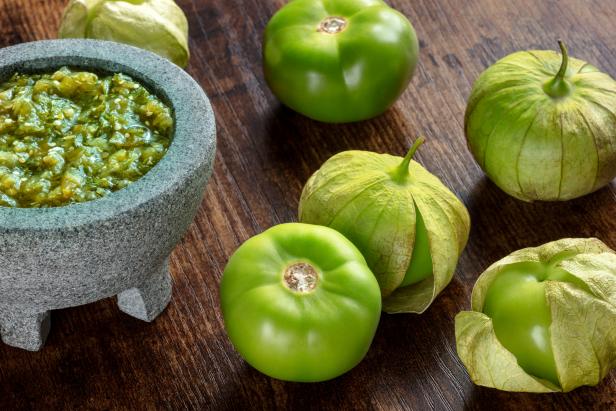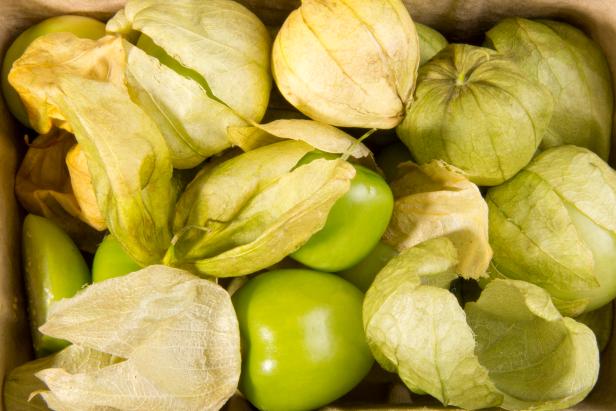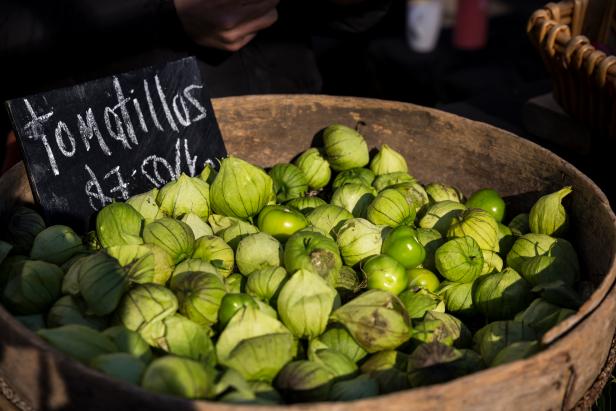What Are Tomatillos?
And three of our favorite ways to cook them.

Plateresca/Getty Images
By Layla Khoury-Hanold for Food Network Kitchen
Layla Khoury-Hanold is a contributor at Food Network.
Tomatillos look a bit like small green tomatoes, but what exactly are they? For more information, we consulted Karla Salinari, holistic health coach, speaker and author of Abuela's Plant-Based Kitchen.

sazlestar/Getty Images
What Are Tomatillos
Tomatillos are small, bright green fruits covered with a thin, papery husk that are native to Central America.
The fruit beneath the husk is smooth, firm, shiny and slightly sticky. Tomatillos are available year-round, but their peak seasons are summer and fall.
Although tomatillos are often referred to as tomate verde, or green tomato in Spanish, they belong to the nightshade family and are not related to traditional red tomatoes. Tomatillos hold a prominent place in Latin American cuisine, particularly in Mexican and Central American dishes, Salinari says. “Tomatillos are a key ingredient in classic sauces such as salsa verde, which adds a vibrant, tangy flavor to dishes like enchiladas, tacos and tamales. Tomatillos are also used to make dishes like pozole verde (a hearty Mexican soup) and green chili sauce. Their unique tartness adds a refreshing and zesty dimension to these recipes. Beyond sauces and soups, tomatillos can be diced and added to salads, grilled as a side dish or even used to create a tangy vinaigrette.”
What Do Tomatillos Taste Like
Tomatillos taste tangy, slightly tart and citrusy, with a hint of sweetness. “Their taste can vary depending on their ripeness,” Salinari says. “As they ripen, they become sweeter and less tangy. The tanginess is a defining characteristic of tomatillos and is why they are a popular choice for adding acidity to dishes.”
Salinary describes tomatillos as having a juicy, crisp flesh, like that of a green apple or firm plum. “This texture makes them a fantastic addition to salsas and sauces, as they provide both moisture and a nice crunch when diced or blended,” she adds. “They can add a bright, refreshing element to various dishes while contributing a subtle complexity that enhances the overall taste profile.”
How to Cook Tomatillos
Salinari shares three different techniques for cooking tomatillos including roasting, sauteing and boiling, and when to use each.

Paco Adame/Getty Images
How to Roast Tomatillos
Roasting tomatillos imparts a smoky, charred flavor that adds depth to salsas, sauces or other dishes.
Step one: Prep. Preheat your oven to 400 degrees F. Remove the papery husks from the tomatillos and rinse them thoroughly under cool water. Cut the tomatillos in half to ensure even roasting.
Step two: Season. Place the cleaned and halved tomatillos on a baking sheet. Drizzle olive oil over the tomatillos and season them with a pinch of salt and pepper. Toss them gently to coat evenly. For added flavor, you can add other ingredients like garlic cloves or chili peppers.
Step three: Roast. Roast tomatillos until they become tender and slightly charred, about 15 to 20 minutes. Keep an eye on them to prevent burning.
Step four: Cool. Once roasted, allow tomatillos to cool slightly before using them in your desired recipe.

Jon Lovette/Getty Images
How to Saute Tomatillos
Sauteed tomatillos can be used as a topping for tacos, as a side dish or to add a burst of tangy flavor to various recipes.
Step one: Prep. Remove the husks from the tomatillos and rinse them under cool water. Dice into small pieces or cut into slices, depending on your preference.
Step two: Heat the oil. Heat a skillet or frying pan over medium-high heat and add a small amount of oil, such as olive oil or avocado oil.
Step three: Saute the tomatillos. Add the diced or sliced tomatillos to the hot pan. Saute them for about 5 to 7 minutes, stirring frequently, until they become slightly softened and develop a golden color around the edges.
Step four: Season. Season the sauteed tomatillos with a pinch of salt, pepper and any additional desired seasonings or herbs, such as cilantro or cumin.

Image Professionals GmbH/Getty Images
How to Boil Tomatillos
Boiled tomatillos will have a milder, less tangy flavor compared to raw tomatillos and work well in soups, sauces or as a base for salsa verde.
Step one: Prep. Bring a pot of water to a boil, ensuring that there’s enough water to cover the tomatillos. Remove the husks from the tomatillos and rinse them under cool water. You can leave them whole or halve them for quicker cooking.
Step two: Boil. Boil the tomatillos until tender, about 5 to 7 minutes. They will turn from bright green to an olive-green color.
Step three: Drain. Using a slotted spoon, remove the tomatillos from the boiling water and drain them.
Step four: Cool. Allow the boiled tomatillos to cool before using them in your recipes.

shells1/Getty Images
Tomatillos vs Tomatoes
Tomatillos and tomatoes might look similar, but they have different origins, appearance, texture, flavor and culinary uses. Here, Salinari breaks down the differences between tomatillos and tomatoes.
Origin: Tomatillos originated in Central America and have been a staple in Latin American cuisine for centuries. Tomatoes originated in South America and have a broader global presence in various culinary traditions.
Appearance: Tomatillos are small, green fruits surrounded by a papery husk. Peeling back the husk reveals a smooth and slightly sticky skin. Tomatoes come in a range of colors, including red, yellow, orange and even purple. They have smooth, shiny skin and are typically larger than tomatillos.
Texture: Tomatillos have a firm and slightly sticky texture beneath their skin. When cooked, they can become tender but still retain some crispness. Tomatoes have a juicy and soft texture when ripe, making them great for fresh salads and sandwiches.
Flavor: Tomatillos have a unique tangy and slightly tart flavor with hints of citrus. They are known for their acidity, which adds a bright, zesty quality to dishes. Tomatoes have a sweeter and milder flavor when ripe, with variations in sweetness and acidity depending on the variety.
Culinary Uses: Tomatillos are used in many Latin American cuisines, particularly in Mexican and Central American dishes, and prized for their ability to add tartness and depth of flavor to sauces, soups and stews. Tomatoes are used in a wide variety of cuisines and dishes, such as salads, sauces, soups, pasta dishes, sandwiches, and as a base for ketchup and tomato paste.

Kathrin Ziegler/Getty Images
Tomatillo Substitutes
There are several substitutes for tomatillos, including green tomatoes, canned green tomatoes, green bell peppers, green apples, limes or vinegar, or a combination of ingredients, Salinari says. She adds that home cooks should keep in mind that these substitutes won’t exactly replicate the flavor profile and texture of tomatillos and that you’ll need to consider what flavor or texture you’re trying to achieve.
Green Tomatoes: Unripe green tomatoes can work as a substitute, especially in recipes where tomatillos are used for their tartness. Green tomatoes have a tangy, slightly sour flavor that can mimic the acidity of tomatillos. They can be used in dishes like salsa verde or green sauces.
Canned Green Tomatoes: Canned green tomatoes, often found in some grocery stores, can be a convenient alternative. They are typically pickled or canned with vinegar, giving them a tart flavor similar to tomatillos. Rinse them before using to reduce the vinegar taste if necessary.
Green Bell Peppers: Green bell peppers can be used as a substitute in recipes that call for tomatillos in cooked dishes like soups, stews or chili. They won't provide the same tartness, but they add a fresh, mild flavor and a nice crunch.
Green Apples: In some recipes where tomatillos are used for their tangy quality, you can substitute green apples. They provide acidity and a hint of sweetness. Be sure to adjust the sugar or sweetness level in the recipe accordingly.
Limes or Vinegar: For recipes where tomatillos are primarily used for their acidic nature, you can use fresh lime juice or vinegar (such as white wine vinegar or apple cider vinegar). Start with a smaller quantity and adjust to taste, as these ingredients can be quite potent.
A Combination of Ingredients: In some cases, you may need to combine several substitutes to mimic the flavor and texture of tomatillos. For example, you can mix green tomatoes with a splash of lime juice to get both tartness and texture.
Related Links:


























.jpg.rend.hgtvcom.231.174.suffix/1629927600593.jpeg)




































